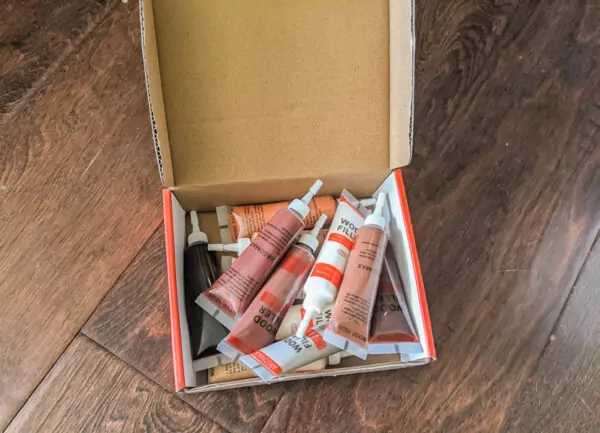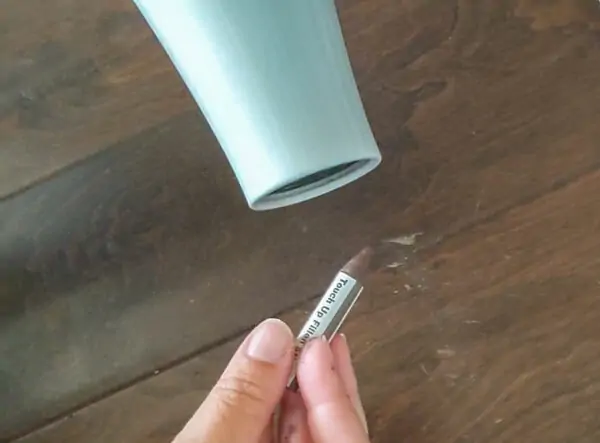After testing a few popular methods, I’m sharing the best way to fix scratches and gouges in your hardwood floors (including engineered hardwoods). This method is super fast and easy and it gives gorgeous results.
We have beautiful dark engineered hardwood floors that I installed around five years ago. I still absolutely love them, but over the years they have gathered quite a few scratches, gouges, and small holes that don’t look so great.
I have three little boys who are incredibly active and they are pretty hard on our house, including our floors. So it is definitely time to do something about all of the scratches our floors have accumulated.
My floors are engineered hardwood floors. Some of the methods you might use to fix scratches in real hardwood floors don’t work so well for engineered floors. However, the method I’m using to fix my scratched engineered hardwoods will also work just fine on solid hardwood floors.
This post contains affiliate links which means if you make a purchase after clicking a link I will earn a small commission but it won’t cost you a penny more. Click here to see my full disclosure policy.
Three ways to fix scratches in hardwood floors
I always start every project I do in our home with some research. I did a bit of research into the best and most popular ways to fix scratches in hardwood floors and chose a few methods that seemed promising to test out for myself.
Touch-up stain
I actually tried this method a couple of years ago since it seemed like the easiest method and I already had all the materials on hand.
I simply used a q-tip dipped in wood stain that closely matched the color of my floors and rubbed it on the worst scratches. Then I used a clean cloth to wipe off any excess.
It was easy enough to do and immediately improved the appearance of the floor. You could still see the scratches if you looked closely, but they were way less noticeable.
Unfortunately, it has now been a couple of years and I can easily see the spots where I did this. I didn’t seal the stain, so the sheen of these spots is more matte than the surrounding floor. And because it wasn’t sealed, it has also faded over time.
Wood Filler Kit
After doing some more searching, I found some small wood filler kits that are popular for fixing scratches in wood floors and furniture.
These kits contain tubes of a resin wood filler in multiple colors to match a variety wood tones. I bought one of these kits with decent reviews to try for myself.

In theory I thought I would really like this solution because it is a very simple one-step process. But in reality it didn’t work so well.
The fillers come in small tubes that make it really easy to apply.
That is, they are easy to apply unless you need to mix a custom color to match your floors which you will almost always have to do. In that case you need to mix the two colors together before applying them to the scratch which is a bit more difficult.
I also didn’t love the consistency of this product. The resin wood filler had a consistency that was more similar to paint than a traditional wood filler so it wasn’t really thick enough to easily fill deeper scratches and holes. ‘
While this kit may work great for fixing scratches in furniture, but it wasn’t quite enough for fixing wood floors.
Wood Repair Markers
I also found that these wood repair marker kits are pretty popular so I ordered one of these to test as well. Luckily, I was much happier with the results.

The kit contains eight wax filler sticks that look like crayons for filling in holes and scratches. It also contains eight markers for fixing the color of the wood scratches. And it came with a sharpener to use for getting a sharp point on the crayons for filling smaller areas.
This kit is pretty simple to use, but I did find there is a bit of a learning curve. At first I had a really hard time figuring out how to make the scratches truly blend in seamlessly.
But I kept experimenting and I figured out a few simple tricks that really help make it easy to get amazing results.

Materials
- Wood Repair Marker Kit – there are several different versions available that all look somewhat similar. This is the kit I used and I was super happy with it.
- hairdryer – for warming the wax crayons
- small plastic putty knife or old credit card – for smoothing the wood filler
- clean cloth or paper towel – for wiping off excess product
How to Fix Scratched Wood Floors
Clean your floors
The first step is to clean your floors thoroughly. It’s fine to use whatever method you usually use to clean your floors; you just want them clean and free of debris that could keep the filler/color from adhering well.

Fill deep scratches and holes with the filler
For deeper scratches and holes, you’ll start with one of the wax crayons in the kit.
There will be several different colors of wax sticks in your kit. The color of the wood filler doesn’t have to exactly match your floors because you will fix any color variations in the next step. But choosing a color that is a pretty close match will make the whole process easier.
You would think you should choose the one that looks the most similar to your floors, but actually it is best to start with one a couple of shades lighter than your floor.
The color often ends up looking much darker than you expected once it’s applied. If you use a color that is too dark, it can be difficult or impossible to lighten it with the wood repair markers; but it is very easy to darken a color that is too light.
Once you’ve chosen a crayon, you need to warm it to soften the wax. Initially, I just tried warming the crayon by holding it in my fist to warm it with body heat, but that really didn’t work very well.
After a bit of experimenting, I realized a hair dryer was the perfect solution. If you warm the tip of the crayon with a hair dryer for five to ten seconds, the wax will soften the perfect amount for it to melt right into the scratches and fill them smoothly.

Once you’ve applied the filler, you can use a plastic putty knife or an old credit card to scrape off any excess filler for a super smooth finish.

Cover scratches and scuffs with the markers
Once everything is nice and smooth, it’s time to pull out the markers. I hope this goes without saying, but these are not the same as the Crayola markers that kids use. These are markers specially formulated for fixing scratches in wood.
These markers are perfect for using on their own to fix scuff marks and superficial scratches as well as using in combination with the filler to fix larger divots and scratches. They will not fill in deep holes and scratches though; that is what the filler sticks are for. The markers only correct the color.
Because this step is all about fixing the color, choosing the right color is especially important.
Be sure to start with a color that is a couple of shades lighter than your floors. If the color ends up being too light, you can always add a second coat to darken it or even add a coat of a darker color.
Using a marker that is too light is easy to fix while using a marker that is too dark is nearly impossible to fix.

Originally I chose two colors that looked closest to my floors and tested them in an inconspicuous area. Even though they looked like they should match, they were actually way too dark! The marker that actually ended up matching well looks much lighter than my actual floors.
Once you’ve figured out which marker looks the best, using them is incredibly easy.
Lightly color over the scratched area with the marker and then wipe it with a clean cloth to remove the excess. The marker will adhere to the raw, exposed wood of the scratches but easily wipes off the rest of the floor that is still sealed.

Just be sure to work in small sections and work quickly because the markers do dry fast. If the marker dries completely without being wiped, it will not blend in well with the rest of your floor.

And that’s it. It really is crazy easy and I have been thrilled with the results.
Here are a few more before and afters from other areas around the house.



And now I’m excited to try using these markers to fix up a few scratches on some wood furniture I have. Somehow it seems like there is always something scratched or broken or in need of repairs around here!
Video Tutorial
I also put together a quick video tutorial showing the whole process that you can watch below.
I’d love for you to subscribe to my Youtube channel!
Other simple fixes I think you’ll love:
- How to Keep Your Shower Curtain from Falling Down
- Save your Couch: How to Clean a Microfiber Couch
- How to Refinish a Worn Out Dining Table
I’d love for you to pin this post on Pinterest!



How to fix scratches on wood floors - the quick and easy way
I’m sharing the best way to fix scratches and gouges in your hardwood floors (including engineered hardwoods).
Materials
- Wood Repair Markers
- Paper Towels
Tools
- Hairdryer
- Small Plastic Putty Knife
Instructions
- Clean your floors thoroughly.
- Fill deep scratches and holes using one of the wax crayons in the wood repair kit. Warm the wax crayons first to soften the wax with a hair dryer and then fill in the scratches.
- Use a plastic putty knife to scrape off any excess filler.
- Use the included markers to fix scuff marks and superficial scratches. Be sure to start with a marker that is a couple of shades lighter than your floor. You can always go over it with a darker marker if needed.
- Lightly color over the scratched area and immediately wipe it clean.
Recommended Products
As an Amazon Associate and member of other affiliate programs, I earn from qualifying purchases.


Katie says
This is super helpful! Thank you!!
Carrie says
So glad it helps!
Red says
The only problem I have found with these is that they don’t age well. I used one of these sticks to cover a scratch on a coffee table, it was caramel colored and the stick that I used matched it perfectly. After a few months it began to change color, and now it is neon orange. I wish I could add a picture but I’m very unhappy with the color now. Suggest doing it in a place where won’t be bothered for a while and watch the Aging.
Carrie says
Great suggestion. My floor is still looking okay, but I will definitely keep an eye out for that and update this post if I see changes. Nobody wants neon orange wood!